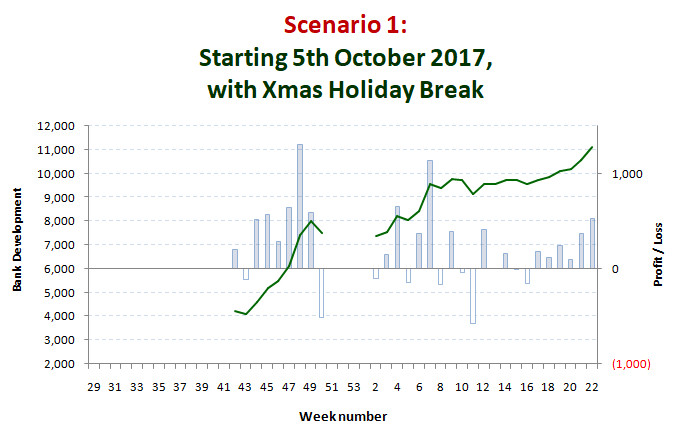
It is also advisable to log the amount of money gambled by other bettors (not only because this is a very strong indicator of price/odds movements, but also for the popularity of the particular type of match; there is nothing worse than having a perfect ‘in-play’ system only to find that the market liquidity is not sustainable enough to place your bet for the correct amount).
 Image: lukethelake (Shutterstock)
Image: lukethelake (Shutterstock)You can also monitor the odds for the home/draw/away markets and many other variables which, you may later use to construct your bet placement trigger.
After you have evaluated around 10-20 matches, you will already have a pretty good database. With the next round of matches you can now adjust your trigger for the first time.
For example, you decide to choose an odds bracket for selected matches (e.g. those with odds between 2.3 and 2.8 for the home win), and set the odds for over 2.5 goals between 1.9 and 2.1.
You can set the parameters for activating your bet placement trigger to, say, the money already turned over in this market with Betfair; perhaps a threshold of over GBP 20,000 turnover, etc.
To develop a good working trigger you need to concentrate on one very small selected group of matches, which you can evaluate and consequently refine the trigger around. The longer you evaluate the more patterns you will recognise, which will allow you to adjust the trigger fairly exactly. At first, do all of this in MarketFeeder test mode as it is wise to wait for confirmed results before actually committing money to the project.
Another example: you develop a trigger which identifies English, German and Italian football fixtures between equally matched teams in terms of odds, and which considers variables such as the time to bet (must be 2 minutes before kick off, or the odds not to exceed a certain amount, or the amount of laid money should not be more than 5 times the amount of backed money, etc.).
If you are satisfied with the parameters of your trigger, you can now start to test it with very small amounts (MarketFeeder allows you to bet with monetary amounts as low as 0.01). Of utmost importance is that you continue to evaluate the logs! After 1-2 months of analysing and gathering information you will have succeeded in developing perhaps one reliable trigger, which has the potential to make money. You must then trial-run the trigger over a period of several weeks using small monetary amounts and continue to evaluate. In the meantime, you can now start working on the next trigger and thus, with time, you will develop a portfolio of various triggers and see your money begin to grow.
A trigger should be selected for very small groups with the same conditions, and an active trigger should ideally not execute more than 5 to 10 times a day to allow you to evaluate the logs and to adjust the trigger even more precisely.
Please don’t expect to find any successful triggers published in the Net; neither on the MarketFeeder sites or anywhere else. You would be mad to give away the secrets of success after months or even years of developing and putting hard work into a project and you should also avoid offers from others selling successful trigger set-ups. Published triggers are obviously the less successful ones but can be used as examples. They may possibly help you develop your own money-making trigger.








Hello there.
Does this work with our value bets?
Do we have to feed in true odds from our excel calculation?
Looking forward to a robot which can ease up a lot of work. Also lesser human betting errors.
TeckChuan
MarketFeeder is good for in-play Betting, as well as for strategy betting. With the triggers you program a certain strategy which the bot is carrying our without the need of user interference.
I use the sofware, but there are a few bugs that are so annoying and making the software crashing frequently.